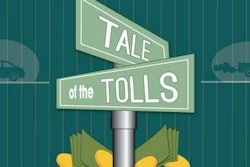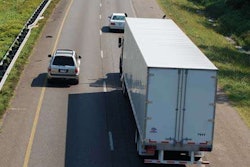A priorities outline, reportedly a draft of the Trump administration’s infrastructure bill preferences, leaked and was published yesterday here. In it, as expected given past reporting on the administration’s ideas around tolling, a road-financing section lists this nugget: “Allow states flexibility to toll on interstates and reinvest toll revenues in infrastructure.”
What does that mean? By various accounts, it looks like the ban on tolling existing interstate lanes (except in some special cases) could be on the chopping block, though there’s plenty opposition to such a measure sure to emerge among both truckers and the motoring public. (Obama’s DOT wanted this done, too, you may recall. Yeah, we’ve been here before.) Some of that opposition was immediately on offer. Cue the Alliance for Toll-Free Interstates, which issued this statement yesterday after it got wind of the leaked plan:
The leaked Trump infrastructure plan is a complete reversal of President Trump’s commitment to putting America First. Although then-candidate Trump campaigned against lining the pockets of Wall Street and promised to be the voice for the working class, this plan does the opposite. President Trump is choosing Wall Street over Main Street. It would take money from hardworking Americans and give huge profits to toll road investors – many of which are foreign companies.

That last little tidbit of information, amid the rhetoric, happens to be true. One need only recall the Indiana Toll Road’s lease by a succession of Australian and other investors to see it, and it’s not the only one. The statement goes on:
The leaked document allows ‘states flexibility to toll on interstates’ and reconciles ‘the grandfathered restrictions on use of highway toll revenues with current law.’ That translates to a complete reversal of the current federal ban on tolling existing interstates.
And echoing the thoughts of many truckers:
Tolls are simply a new tax. They are wildly inefficient, sacrificing money that could go toward construction instead going to corporate profits and administrative costs. In addition to the diversion onto secondary roads which causes congestion and public safety issues, tolls will do unimaginable harm to businesses, as shipping and manufacturing prices skyrocket to account for these new costs.
Arguments for tolling fill the headspace where thoughts on the reality of the rise in electric vehicles and lawmakers’ inability to sell increased fuel taxes to tax-wary constituents leave diminishing fuel-tax revenue for road-building and -maintenance in their wake. Nonetheless, it remains the case that the principle vehicle for highway funding remains those fuel taxes (as some states have begun charging annual fees for electric vehicles to make up some of the difference), and turning existing, long-open, non-tolled lanes on federal-aid highways into tolled facilities is considered a particularly onerous move by many highway users. It’s a fact that none of the three open spots in the long-ago-established (1998) pilot program for tolling existing interstate lanes has ever been claimed successfully by any state. In some cases applications to participate have fallen hard after strong local opposition.
In October, the Federal Highway Administration quietly reopened those three spots in the old program for new applications. The deadline for those applications is fast approaching — February 20 — and FHWA notes that several states have expressed interest so far. No applications have been finalized, however.
For further reading on the draft infrastructure plan, catch this report in our sister publication CCJ.
And weigh in here on your thoughts around tolling existing interstates:
Not ‘failing to distinguish between a tractor-trailer and the bright white sky’ exactly, but …
Tesla’s not-so-aptly-named Autopilot feature in its cars allows some measure of the vehicle’s control to be turned over to the car itself, and not just the speed (a la cruise control).
The high-profile fatality accident that occurred in Florida when a Tesla in Autopilot mode crashed at high speed under a trailer that was turning across the road in front of it was investigated by the NTSB and determined to be in part the fault of the system’s sensors’ doing (or not doing, as it were) what is quoted above in the subhead. In that event, the trucker was partly deemed at fault as well, and the deceased driver deemed not to have been sufficiently attentive, too, to the road ahead.
Another incident has occurred with Autopilot engaged, this one on I-405 in Culver City, Calif., that saw the driver crash the car into a fire truck parked in a lane assisting in the aftermath of a motorcycle accident. Fortunately in this case, no one was injured.
From CNBC: “Autopilot is intended for use only with a fully attentive driver,” Tesla said in a statement sent to CNBC. The firetruck was on the freeway helping after a motorcycle accident, the [local firefighters’] union said in an Instagram post.”
Here’s what it looked like in the aftermath of the relatively-high-speed crash.
And that’s not the only recent incident to emerge from ‘Autopilot’ misuse, according to this report in Fortune, with a quite interesting first paragraph:
The California Highway Patrol (CHP) says a driver was found passed out in his Tesla with a very high blood alcohol content on San Francisco’s Bay Bridge on Friday. The driver, according to CHP, claimed the car had been “set on autopilot” in an apparent attempt to defend himself.
As we’ve written before, such semi-autonomous driving features are only as good as their failsafe — the driver behind the wheel. If it’s a guy blowing twice the legal alcohol limit, apparently the case here, well, not too good.










